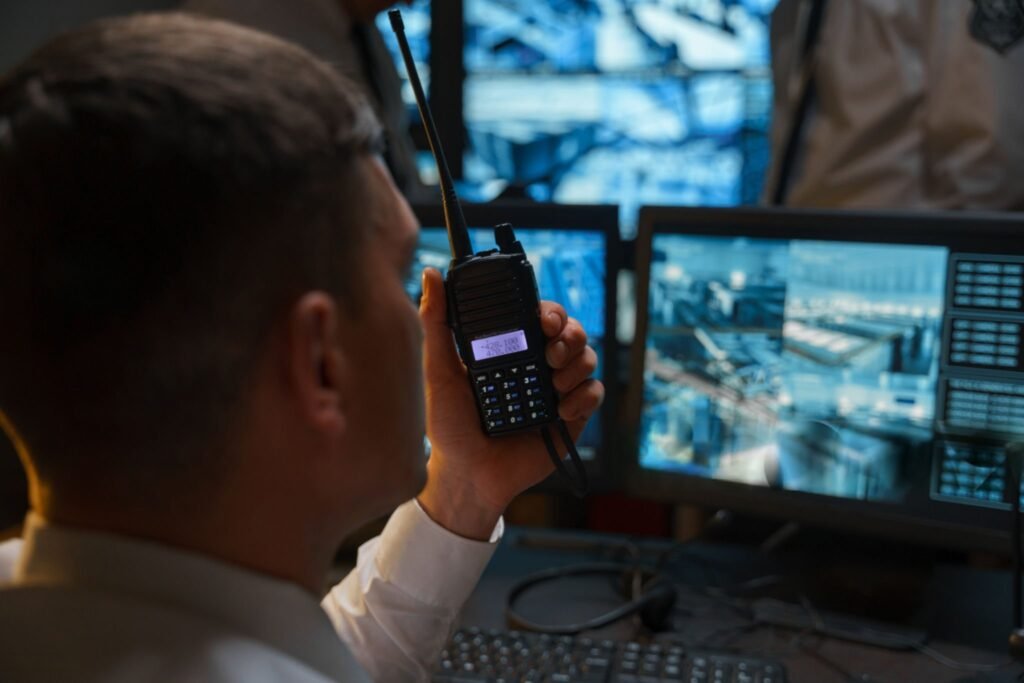
In today’s interconnected world, the Internet of Things (IoT) is revolutionizing industries across the board, and the realm of walkie-talkie communication is no exception. For decades, walkie-talkies have been indispensable tools for instant voice communication, particularly in sectors requiring on-the-ground coordination. However, the integration of IoT technology is transforming these traditional devices into powerful, data-driven communication hubs, significantly enhancing their functionality and propelling market growth. This article explores the pivotal role of IoT integration in the walkie-talkie industry, examining how it’s reshaping capabilities, expanding applications, and driving market evolution.
Understanding the Convergence: IoT Meets Walkie-Talkie Technology
To grasp the impact of IoT in walkie-talkies, it’s essential to understand both technologies individually and their powerful synergy.
What is IoT?
The Internet of Things (IoT) refers to a network of physical objects embedded with sensors, software, and other technologies that enable them to connect and exchange data with other devices and systems over the internet. This interconnectedness allows for real-time data collection, analysis, and automated actions, creating smarter and more efficient systems across various applications.
Walkie-Talkies: The Foundation of Instant Communication
Walkie-talkies, also known as two-way radios, have long been the cornerstone of instant, push-to-talk voice communication. Their simplicity, reliability, and ability to function without cellular networks make them vital in industries like construction, security, logistics, public safety, and event management.
The Power of Integration: IoT-Enabled Walkie-Talkies
The integration of IoT into walkie-talkies bridges the gap between simple voice communication and data-driven intelligence. IoT-enabled walkie-talkies, often referred to as smart walkie-talkies or connected radios, go beyond basic push-to-talk functionality. They leverage IoT connectivity to:
- Transmit and Receive Data: Beyond voice, these devices can transmit and receive data, including location information, sensor readings, and text messages.
- Connect to Networks: IoT integration allows walkie-talkies to connect to Wi-Fi, cellular networks, and other IP-based networks, extending communication range and enabling integration with broader communication ecosystems.
- Utilize Cloud Platforms: Data collected by IoT walkie-talkies can be processed and analyzed on cloud platforms, providing valuable insights and enabling advanced applications.
Enhanced Functionality: Unlocking New Capabilities with IoT Integration
IoT integration significantly enhances walkie-talkie functionality, offering a range of new capabilities that were previously unattainable with traditional analog or even basic digital systems. These enhancements are driving significant value for businesses across various sectors:
- Extended Communication Range and Interconnectivity: By leveraging IP networks and cellular connectivity, IoT walkie-talkies overcome the range limitations of traditional radios. They can facilitate communication across vast distances, connecting teams locally, regionally, or even globally. Interoperability with smartphones and computer systems further expands communication reach and flexibility.
- Real-Time Location Tracking and GPS Integration: GPS-enabled IoT walkie-talkies provide real-time location tracking of personnel and assets. This is invaluable for dispatching, resource management, and enhancing worker safety, particularly in industries like logistics, security, and emergency services. Location data can be visualized on maps and integrated with dispatch software for optimized operations.
- Data Collection and Sensor Integration: IoT walkie-talkies can be equipped with sensors to collect environmental data (temperature, humidity, gas levels), equipment status, or worker biometrics. This data can be transmitted in real-time, enabling proactive monitoring, predictive maintenance, and improved safety protocols. For example, in hazardous environments, gas sensors integrated into walkie-talkies can alert workers to dangerous conditions.
- Advanced Analytics and Reporting: Data collected from IoT walkie-talkies can be analyzed to generate valuable insights into communication patterns, operational efficiency, and resource utilization. This data-driven approach allows businesses to identify bottlenecks, optimize workflows, improve resource allocation, and make informed decisions to enhance overall performance.
- Remote Management and Configuration: IoT connectivity enables remote management and configuration of walkie-talkie fleets. Administrators can remotely update software, adjust settings, monitor device status, and troubleshoot issues, reducing downtime and streamlining device management, especially for large deployments.
- Integration with Business Applications and Platforms: IoT-integrated walkie-talkies can be seamlessly integrated with other business applications, such as CRM, ERP, and workforce management systems. This integration creates a unified communication and data ecosystem, streamlining workflows, improving data accuracy, and enhancing overall operational visibility. For example, integrating with work order management systems can automate task dispatching and status updates directly through the walkie-talkie.
- Enhanced Emergency Features and Safety Protocols: IoT walkie-talkies can incorporate advanced emergency features, such as man-down alerts, panic buttons, and automated emergency dispatch triggered by sensor data or location anomalies. These features significantly enhance worker safety and improve emergency response times in critical situations.

Market Growth and Opportunities: IoT Integration Fuels Expansion
The enhanced functionality driven by IoT integration is a major catalyst for market growth in the walkie-talkie industry. Several factors contribute to this expansion and present significant opportunities:
- Increased Demand for Data-Driven Communication: Businesses are increasingly seeking data-driven solutions to optimize operations and improve decision-making. IoT-enabled walkie-talkies meet this demand by providing valuable data insights alongside voice communication.
- Growing Adoption in Key Vertical Markets: Sectors like logistics and transportation, manufacturing, construction, public safety, and security are rapidly adopting IoT walkie-talkies to enhance efficiency, safety, and operational control. These sectors represent significant growth markets for IoT-integrated communication solutions.
- Technological Advancements and Cost Reduction: Continued advancements in IoT technologies, including sensors, connectivity, and cloud platforms, are making IoT walkie-talkies more affordable and accessible to a wider range of businesses. Decreasing costs are further accelerating market adoption.
- Expansion of IoT Ecosystem: The overall growth of the IoT ecosystem creates a favorable environment for IoT walkie-talkies. As more devices and systems become interconnected, the value proposition of IoT-integrated communication solutions becomes even more compelling.
- Focus on Worker Safety and Compliance: Increasing regulatory focus on worker safety and operational compliance is driving demand for technologies that enhance safety protocols and provide real-time monitoring. IoT walkie-talkies offer robust safety features and data logging capabilities that address these needs.
Real-World Applications: IoT Walkie-Talkies in Action
The benefits of IoT-integrated walkie-talkies are being realized across diverse industries. Here are a few examples of real-world applications:
- Logistics and Transportation: Logistics companies use GPS-enabled IoT walkie-talkies to track vehicles, manage drivers, optimize delivery routes, and ensure timely communication between dispatchers and drivers. Sensor integration can monitor cargo conditions (temperature, humidity) for sensitive goods.
- Construction and Manufacturing: On construction sites and in manufacturing plants, IoT walkie-talkies enhance team coordination, improve safety through man-down alerts and emergency features, and enable data collection from equipment sensors for predictive maintenance and operational monitoring.
- Security and Public Safety: Security personnel and first responders utilize IoT walkie-talkies for secure communication, real-time location tracking, and dispatch coordination. Integration with sensor networks and emergency response systems further enhances situational awareness and response effectiveness.
- Event Management: Event organizers leverage IoT walkie-talkies for seamless staff communication, crowd management, security coordination, and real-time updates. Location tracking and data analytics help optimize staffing and resource allocation during events.
- Healthcare: Within hospitals and healthcare facilities, IoT walkie-talkies improve staff communication, facilitate rapid response to emergencies, and enable integration with patient monitoring systems. Location tracking can optimize staff deployment and asset management.

Challenges and Considerations for IoT Walkie-Talkie Adoption
While the potential of IoT-integrated walkie-talkies is immense, businesses should consider certain challenges and factors when implementing these systems:
- Security Concerns: As with any IoT device, security is paramount. Robust security protocols, encryption, and secure data transmission are essential to protect sensitive communication and data from cyber threats.
- Interoperability and Standards: Ensuring interoperability between different IoT walkie-talkie systems and with existing communication infrastructure is crucial. Adherence to industry standards and open protocols is important for seamless integration.
- Infrastructure Requirements: Implementing IoT walkie-talkies might require investment in network infrastructure, such as Wi-Fi networks, cellular connectivity, or dedicated IoT gateways, depending on the application and coverage needs.
- Power Management and Battery Life: Adding IoT capabilities can increase power consumption. Optimizing power management and battery life is crucial for ensuring long operational hours, especially for devices used in the field.
- Cost of Implementation and ROI: Businesses need to carefully evaluate the initial investment costs and long-term return on investment (ROI) when transitioning to IoT walkie-talkie systems. While the benefits are significant, a clear understanding of the cost-benefit analysis is essential for informed decision-making.
The Future Landscape: IoT Walkie-Talkies Leading the Way
The future of walkie-talkie communication is undeniably intertwined with IoT. As IoT technology continues to advance and become more integrated into business operations, IoT-enabled walkie-talkies will become increasingly sophisticated, powerful, and indispensable. We can expect to see:
- Enhanced AI and Machine Learning Integration: Future IoT walkie-talkies will likely incorporate AI and machine learning capabilities for advanced voice recognition, predictive analytics, and proactive alerts, further enhancing their intelligence and value.
- 5G and Advanced Connectivity: The rollout of 5G networks will provide faster, more reliable, and lower latency connectivity for IoT walkie-talkies, enabling even more data-intensive applications and seamless integration with other 5G-enabled devices and systems.
- Miniaturization and Wearable Designs: IoT walkie-talkie technology will continue to miniaturize, leading to smaller, lighter, and more wearable devices, further enhancing user convenience and expanding applications in various sectors.
- Customization and Vertical-Specific Solutions: We will see a growing trend towards customized IoT walkie-talkie solutions tailored to the specific needs of different vertical markets, with specialized features and functionalities optimized for each industry.
Embracing the IoT Revolution in Walkie-Talkie Communication
IoT integration is fundamentally transforming the walkie-talkie industry, moving it beyond basic voice communication into a realm of data-driven intelligence and enhanced functionality. IoT-enabled walkie-talkies are not just communication devices; they are becoming critical components of connected business ecosystems, driving efficiency, safety, and innovation across diverse sectors. As the IoT landscape continues to evolve, businesses that embrace the digital transformation of walkie-talkie communication will be best positioned to leverage the power of connected technology and thrive in the increasingly interconnected world.
Explore the possibilities of IoT-integrated walkie-talkies for your business. Contact us to learn more about how our smart walkie-talkie solutions can enhance your operations and drive market growth.
Keywords: IoT Walkie-Talkie, IoT Integration, Smart Walkie-Talkie, Connected Radio, Walkie-Talkie Market Growth, IoT in Two-Way Radio, Digital Radio Communication, IoT for Business Communication, Industrial IoT, Logistics Communication, Security Communication, Emergency Communication, GPS Walkie-Talkie, Data-Driven Communication, Wireless IoT Solutions.
